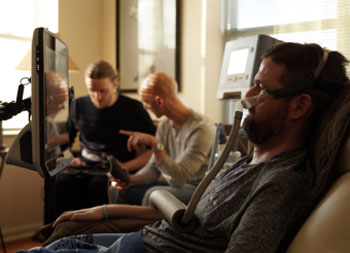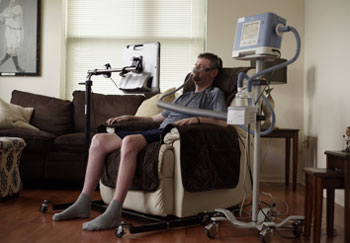Pat Quinn ALS Ice Bucket Challenge Founder Interview

ALS Ice Bucket Challenge
Patrick Quinn is thirty-four years old and was born and raised in Yonkers, New York. In March of 2013, a month after his 30th birthday, Pat was diagnosed with Amyotrophic Lateral Sclerosis (ALS – otherwise known as Motor Neurone Disease). Shortly afterwards, Pat committed to a mission of spreading awareness for this little-known disease. He became a strong advocate explaining to others that having no effective treatments or a cure is not acceptable.
In July of 2014, the biggest movement in ALS and fundraising history began: the ALS Ice Bucket Challenge. Pat was at the forefront of the ALS Ice Bucket Challenge where he connected networks to facilitate in popularising the Ice Bucket Challenge around the United
States and around the world.
The ALS Ice Bucket Challenge raised over USD$115,000,000 globally. Pat went on to become a major advocate for ALS; speaking before Congress, at inspirational speaking engagements with companies like Google and Facebook, and guest speaking at schools, universities and colleges. Pat has received many accolades for his advocacy work including a nomination for TIME Magazine Person of the Year.
In 2017 ALS finally robbed Pat of his voice. In March 2018, Project Revoice returned it to him.
Interview with Pat Quinn
Question: When were you first diagnosed? Tell us about your diagnosis. How did you initially feel/respond/react?
Pat Quinn: I was diagnosed with ALS back on March 8th 2013. My first noticeable symptoms date back to August 2011. I was only 28, so the last thing I was thinking about was having a terminal illness. After almost two years, it was finally conclusive that I was diagnosed with the disease. I remember every second of that day. It's not a day you forget. I was up in Baltimore at Johns Hopkins with my mother and girlfriend. Everything was pointing in the direction of ALS, but I still had this little hope that somehow, they would find something else. They did not. Immediately after hearing those three dreaded letters, I left the hospital by myself and sat on a bench. I was in a state of shock just staring at the sky.
This moment is so vivid in my head. I can recall every little detail. It was a blue sky, scattered clouds, cold breeze, and people were walking by every couple of seconds. But none of it mattered. My world just stopped for a bit. At the age of 30, I was diagnosed with ALS.
Question: Talk us through your experience of the disease.
Pat Quinn: I remember the first time I noticed something wrong. It was the morning after I played in an all-day softball tournament. My left arm was twitching and it wouldn't stop. I just assumed my arm was tired, but the twitching would never stop. It would start in my left arm, move to my right arm, and would eventually move to my legs. The twitching has never stopped. My weakness would start in my hands, beginning with my fingers. I wasn't able to put my fingers together. They were slowly separating and I was unable to move them back together. This is when I knew something was wrong. My hands would weaken, then my arms, then my neck, and it worked its way to my legs. The last thing I noticed was my voice. The disease progressed over the past seven years, probably longer. Slowly but surely, ALS has destroyed my physical body.
 uestion: How did you get involved with the ALS community?
uestion: How did you get involved with the ALS community? Pat Quinn: After the initial shock of the diagnosis wore off, I made the decision to publicly fight, put myself out there, and hopefully make a difference. I decided to put a team together for the local ALS Walk. We named our team Quinn for the Win. Over 200 people would show up to support my fight. This is the first time I felt like I could really do something positive. The ALS community is made up of some of the best people I've ever met. Through social media like Facebook, I would connect with patients all over the world. I continue to connect with people today.
Question: Tell us about your awareness/fundraising activities pre-Ice Bucket Challenge?
Pat Quinn: I believe creating awareness is the key to building support for ALS. Awareness leads to support and support leads to funding. Fundraising prior to the Ice Bucket Challenge was pretty traditional. We ran basketball tournaments, golf outings, concerts, and events at bars or restaurants. I'm so lucky to have the people around me that I do. My local community in Yonkers is incredible! Social media makes networking and connecting with other ALS patients easier than ever. Through Facebook, we were able to meet so many amazing fighters. We would document our journey showing everyone we could that we were living with ALS, not just dying from it.
Question: Tell us about your role in the Ice Bucket Challenge, how did you feel as your saw it attract global attention? Did you ever imagine that the Ice Bucket Challenge would be such a global phenomenon?
Pat Quinn: The Ice Bucket Challenge was a crazy time! A worldwide movement like the Ice Bucket Challenge doesn't just happen. Life will present you with opportunities. It's up to us to make something happen. The Ice Bucket Challenge wasn't originally for ALS. It was going around for a number of different causes until one golfer in Florida took the challenge for his cousin's husband who had ALS.
It caught on in this patient's town close to me and the power of social media brought it to my attention. I will never forget the day I saw a friend from grade school take the challenge and said he was doing it in my honor.
No one could have imagined what was about to happen. All of the local events, community outreach, speaking, networking, and everything else I did in that first year and a half following my diagnosis, it led me right to the ALS Ice Bucket Challenge. I was lucky enough to be in the right place and time to make the Ice Bucket Challenge grow. Being so active, I built a strong supportive network and connected with the right people to take it to new levels. I reached out to another young patient shortly after diagnosis, Pete Frates, and our friendship would be the key to the challenge. This New York to Boston bond would be the key to the growth of the ALS Ice Bucket Challenge. The support for ALS I was hoping to create was taking place right before my eyes. As it happened, my head was spinning. It was surreal. Hundreds of likes on every Facebook post. New videos were being uploaded every couple of seconds. I could never have imagined, not in my wildest dreams, that the Ice Bucket Challenge would become this global phenomenon. Every time I thought to myself, this can't get any bigger, the next day would somehow get bigger.
The power of this positive movement was life changing. The Ice Bucket Challenge would take me all over the world. I did what I set out to do in creating unparalleled awareness leading to research that will one day make ALS treatable and God willing cured.
Question: What will this [Project Revoice] technological advancement mean to you?
Pat Quinn: This technological advancement means everything to how I communicate. I will no longer avoid getting involved in conversations. I won't have people come stand behind me to read what I type. This is what I would do instead of using the computerized voice already on the eye gaze. This technology gives me back a piece of myself that was missing. ALS takes and takes and takes. This time I will take something back!
Question: What do you hope this technology will mean for new ALS/MND patients around the world?
Pat Quinn: This technology will change the way newly diagnosed patients fight back. This takes voice banking to a whole new level. When I was diagnosed, I had the option of recording everything, literally everything I say, or use the generic voice already on the eye gaze computer. I didn't want to waste the time while I could still be active. After hearing my voice through this new technology, I was blown away! For patients to know they can have their own voice after ALS takes it away, it will change the way people live with ALS. It's amazing!
For more information on Project Revoice and to sign up for updates, visit www.projectrevoice.org
MORE



